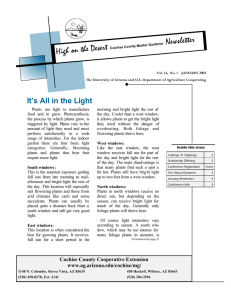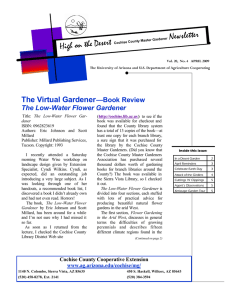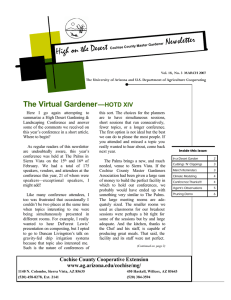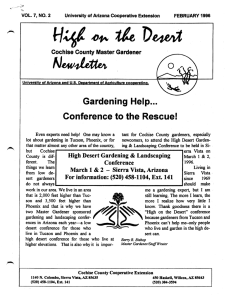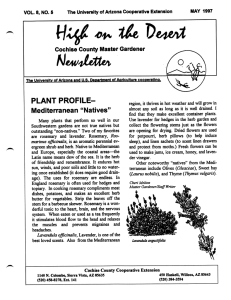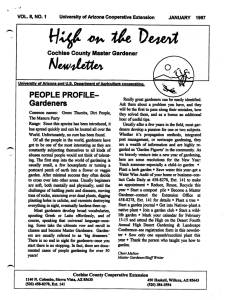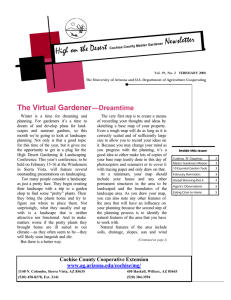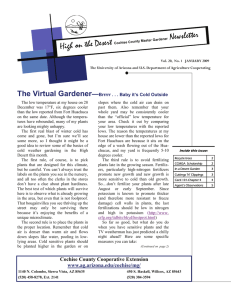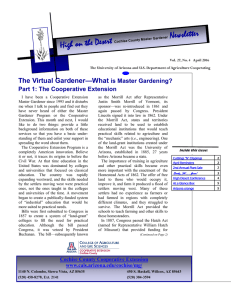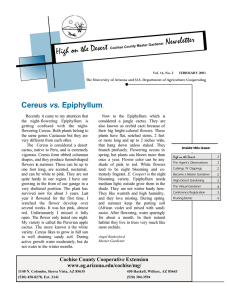Newsletter High on the Desert
advertisement
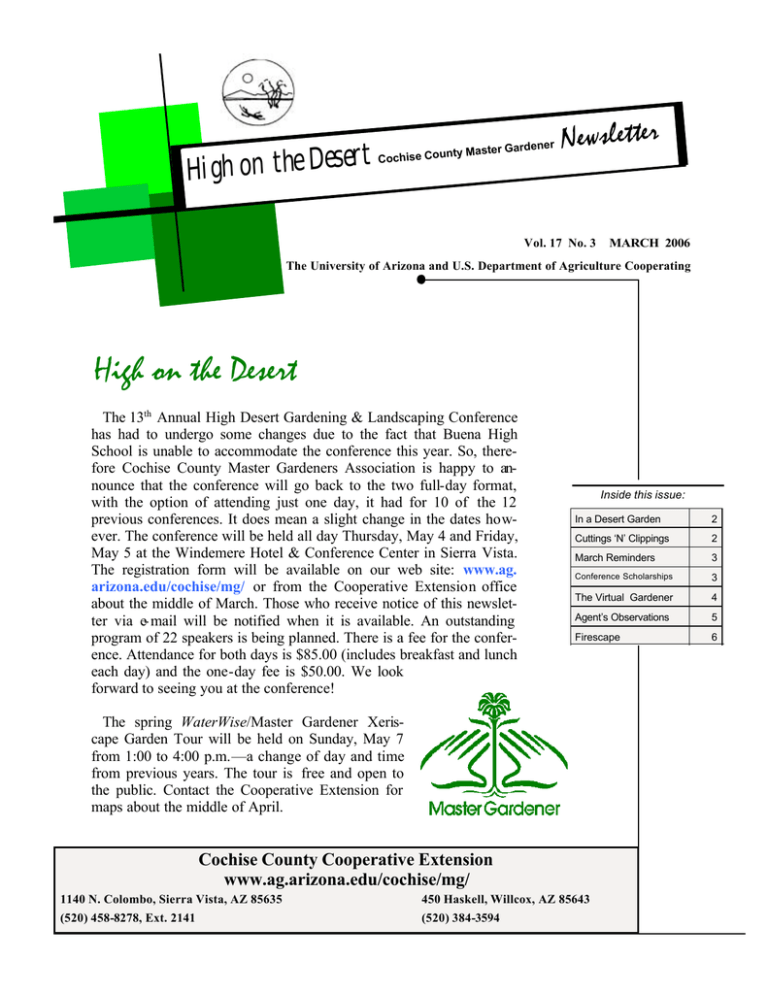
t r e s e D e h t n o h g i H ardener nty Master G Cochise Cou Newsletter Vol. 17 No. 3 MARCH 2006 The University of Arizona and U.S. Department of Agriculture Cooperating High on the Desert The 13th Annual High Desert Gardening & Landscaping Conference has had to undergo some changes due to the fact that Buena High School is unable to accommodate the conference this year. So, therefore Cochise County Master Gardeners Association is happy to announce that the conference will go back to the two full-day format, with the option of attending just one day, it had for 10 of the 12 previous conferences. It does mean a slight change in the dates however. The conference will be held all day Thursday, May 4 and Friday, May 5 at the Windemere Hotel & Conference Center in Sierra Vista. The registration form will be available on our web site: www.ag. arizona.edu/cochise/mg/ or from the Cooperative Extension office about the middle of March. Those who receive notice of this newsletter via e- mail will be notified when it is available. An outstanding program of 22 speakers is being planned. There is a fee for the conference. Attendance for both days is $85.00 (includes breakfast and lunch each day) and the one-day fee is $50.00. We look forward to seeing you at the conference! Inside this issue: In a Desert Garden 2 Cuttings ‘N’ Clippings 2 March Reminders 3 Conference Scholarships 3 The Virtual Gardener 4 Agent’s Observations 5 Firescape 6 The spring WaterWise/Master Gardener Xeriscape Garden Tour will be held on Sunday, May 7 from 1:00 to 4:00 p.m.—a change of day and time from previous years. The tour is free and open to the public. Contact the Cooperative Extension for maps about the middle of April. Cochise County Cooperative Extension www.ag.arizona.edu/cochise/mg/ 1140 N. Colombo, Sierra Vista, AZ 85635 450 Haskell, Willcox, AZ 85643 (520) 458-8278, Ext. 2141 (520) 384-3594 PAGE 2 In a Desert Garden Cuttings ‘N’ Clippings Apache Plume – Fellugia paradoxa This is a shrub that can take extreme drought and does very well in our area. Unfortunately it is not easy to come by. This shrub is native to the higher elevations of Utah and south to Texas. You can find it in Colorado, in the High Deserts of California and Arizona, and in Northern Mexico. The plant has a lacy appearance due to its small leaves and dainty roselike single white flowers. The flowers appear all summer long being replaced by pink fuzzy seed heads that resemble feather dusters and turn to tan with age. The shrub is semievergreen, slowly growing to 4–6 feet tall and up to 5 feet wide. It is not bothered by deer or rabbits. When I planted the garden in front of the Visitor’s Center of Ramsey Canyon Preserve, I put in two Apache Plumes and over all these years they have never been eaten by any animals. The plant needs gritty, well draining soil. In my garden I have heavy clay soil so I planted my plant in front of my house on the island. Be Robert E. Call Extension Agent, Horticulture Carolyn Gruenhagen Editor T The next CCMGA meeting is 5:00 p.m. Thursday, March 2, 2006 at the UAS campus, Room 503. The speaker will be Dr. Mary Olson, Extension Specialist and Professor of Plant Pathology and Microbiology, University of Arizona, Tucson. Fellugia paradoxa careful not to over water as the plant will not tolerate a lot of irrigation in winter. This is a truly drought tolerant shrub. This drought tolerance makes the plant a good candidate to be planted on a hill for erosion control. Here in the High Desert the plant loves full sun but can take quite a bit of shade as well. The plants I planted at the Ramsey Canyon Preserve are more or less in semi-shade and have grown quite a bit larger there than the one I planted on my island in full sun. Overall it is a fine textured shrub with interest all year long. The bark is very attractive, too. Mature stems have peeling bark while younger branches and twigs are covered with gray fuzz. Propagation is through seeds. Angel Rutherford, Master Gardener T The March WaterWise workshop will be held March 4 from 9:00—11:00 a.m. at the Arizona Folklore Preserve. Arborist Mike Fleming will present Pruning Landscape Plants for Health and Fire Safety. T The Sierra Vista Farmers Market will open on Earth Day, Saturday, April 22, in conjunction with the West End Block Party to mark Sierra Vista’s 50th Anniversary. The regular farmers market vendors will be there as well as Earth Day demonstrators and exhibitors at the same location, the NW corner of Carmichael and Wilcox, that the market was held at last year. The hours will be from 10:00 a.m.— 3:00 p.m. After this opening the farmers market will revert to Thursdays, beginning April 27 and probably to mornings, from 8 to noon, instead of afternoons to avoid the monsoons, For informa t i o n c o n t a c t V a l e r i e McCaffrey, Manager, Sierra Vista Farmers Market at (520) 378-2973 or vallimac@cox.net. PAGE 3 High on the Desert The Cochise County Master Gardeners Association (CCMGA) is awarding two full scholarships to the 2006 High Desert Gardening & Landscaping Conference to be held at the Windemere Hotel & Conference Center May 4 & 5. Applicants are invited to submit an essay on one of the following topics: Gardening for food production Landscaping with native plants Environmental stewardship Essays must meet the following criteria: 1. 2. 3. 4. 5. 750 to 1,000 words in length. Double spaced and typed on pla in bond paper. Represent original scholarship and be suitable for publication. All references and authorities cited must be properly attributed. Entries must be accompanied by an official cover sheet obtainable from the Cooperative Extension Office at the U of A South campus or on the web site. Entries must be received at the Cooperative Extension Office at the U of A South campus not later than close of business on April 15, 2006. Entries will be judged by the Cochise County Horticultural Extension Agent and a committee of Master Gardeners appointed by the President of CCMGA. Winners will be notified by April 21, 2006 and the names of awardees will be announced in the May 2006 Cochise County Master Gardener Newsletter. March Reminders ♦ ♦ ♦ ♦ ♦ Prune roses Start seeds indoors Check cactus for fungus Plant cool-season veggies Reconsider your water usage—call WaterWise for a free audit ♦ Remove and replace winter mulches Did you know? Percent of households with the hobby: stamp collecting 7% woodworking 21% bird watching 17% flower gardening 51% needlework 22% quilting 10% wine appreciation 13% sweepstakes 14% coin collecting 27% - Shopper’s Voice Corrections The Blue Stake number was incorrect in last month’s newsletter. It is 800-782-5348 The author’s name of The Sierra Vista Library Garden was missing on the mailed copies of the newsletter. The author was Gary A. Gruenhagen, Master Gardener. PAGE 4 The Virtual Gardener—Xeriscape Principles The term xeriscape was coined by the Water Department of the City of Denver, Colorado in 1981. The word combines the Greek word xeros, meaning dry, with the English word landscape and refers to landscaping techniques for conserving water. There are seven principles for creating a xeriscape. 1. Plan and Design. In xeriscaping as with almost every other endeavor, a good plan is the key to success. A xeriscape design is centered around a concept of grouping plants in zones according to their water requirements. High water users are clustered close around the house in a mini “oasis.” Surrounding the oasis is a zone comprising plants of intermediate water requirements, and at the farthest extremes is a zone containing the plants with the lowest water requirements. 2. Creat Practical Turf Areas. Turf is the largests consumer of water in most yards. Turf areas are minimized in xeriscapes. 3. Use Appropriate Plants and Zone the Landscape. This should be obvious. Xeriscapers like to use native plants in their gardens and yards because they are adapted to the local climate. 4. Soil Improvement. The xeriscaper improves the water retention properties of the soil by adding lots of organic material. 5. Use Mulches. Organic mulches such as straw, bark or compost, or inorga nic rock mulches trap moisture and keep the soil cool to minimize loses to evaporation. 6. Irrigate Efficiently. Use drip irrigation wherever possible to cut down on water usage. 7. Maintain the Landscape Appropriately. Once you have installed your xeriscape, check it periodically to make sure it is doing what you intended. Be sure to check your irrigation system for leaks. For on-line information on xeriscaping, search Google for the term “xeriscape.” http://www.xeriscape.org/whatis. html Until next time, happy surfing! Plan to attend the May 7 Water Wise/Master Gardener sponsored Xeriscape Garden Tour and see techniques of xeriscaping in several gardens in the greater Sierra Vista area. Maps for the self-guided tour will be available from the Cooperative Extension office mid-April. Gary A. Gruenhagen, Master Gardener gruenha@sinosa.com PAGE 5 The Agent’s Observations What can I do to lower the pH of irrigation water? I have 50 pecan trees on my property that are about 10 years old and 20 feet high. They did not grow well last year and had yellow leaves. I believe that the well water is causing the problem because it has a pH of 8.5. Q Water pH can be lowered using acid. There are several to choose from but will be expensive. However, that is not the problem. After asking about the pecan tree fertilizer program it was learned each pecan tree was given a couple of tablespoons of 5% nitrogen containing fish emulsion. Each pecan tree will require a little over three pounds of nitrogen. The amount of 5% fish emulsion needed per tree would be a little over 62 pounds, to meet the three pound requirement! Acidifying the water will not help this situation but nitrogen will. A Q Do fruit trees need to be pruned every year? If so, how late in the winter can they be pruned? A Fruit trees should be pruned annually. This will promote new growth, which in turn will bear fruit the following years. It takes a year or two for this year’s new shoots to produce flower buds. When flowers are pollinated and a fruit begins to grow. Pruning should be done during the dormant season, normally beginning in January. Pruning can be done until shortly after the petals of the blossoms fall. However, if there are flowers on the trees while pruning there will be honeybees visiting the flowers and pollinating. They will be busy foraging for nectar and pollen and are unlikely to become aggressive and sting. That does not mean that they will not, so be careful. The best bet is to complete pruning of fruit trees before they begin to flower. I have heard that the glassy winged sharpshooter insects have been detected in Cochise County by the Arizona Department of Agriculture. Should I be concerned and what can I do about it? Q A Yes, last fall the glassy winged sharpshooters were found by the Arizona Department of Agriculture on monitoring traps at a local nursery. After further trapping, over 20 insects were found. These insects occur naturally in the Southeastern United States and are now naturalized in Southern California. Most likely the glassy winged sharpshooters “hitched a ride” on nursery stock produced in California. These leafhopper type insects can transmit Pierce’s disease, a bacterium, which infects woody plants, causing them to wilt and die. There is no cure. They also can transmit plant viruses. The Arizona native green-blue sharpshooter also transmits Pierce’s disease and has infected grape vineyards in Santa Cruz County. The glassy winged sharpshooter over winters as an adult. They are reported to die if temperatures of 20° F. or below are reached. Although we have had an exceptionally warm winter, there has been cold weather. In December, night time temperatures fell into the teens. Hopefully the sharpshooter adults have died, but monitoring will continue in the Sierra Vista area by the Department of Agriculture. Reference: http://www.ipm. ucdavis.edu/pmg/pestnotes/ pn7492.html Robert E. Call Extension Agent, Horticulture Issued in furtherance of Cooperative Extension work, acts of May 8 and June 30, 1914, in cooperation with the United States Department of Agriculture, James A. Christenson, Director, Cooperative Extension, College of Agriculture and Life Sciences, The Univ ersity of Arizona and Arizona Counties cooperating. The University of Arizona is an equal opportunity, affirmative action institution. The University does not discriminate on the basis of race, color, religion, sex, national origin, age, disability, veteran status, or sexual orientation in its programs and activities. The information given herein is supplied with the understanding that no discrimination is intended and no endorsement by Cooperative Extension is implied. Any products, services, or organizat ions that are mentioned, shown, or indirectly implied in this publication do not imply endorsement by the University of Arizona. The University of Arizona Cooperative Extension Cochise County 450 S. Haskell Avenue Willcox, AZ 85643-2790 Firescape The Southwest Fire Management Board recommends the following to reduce the threat of wildland fires. Take time to protect your home! 1. Stack firewood away from the house. 2. Thin and prune trees and shrubs. 3. Maintain a circle of safety— at least 30 feet or greater on slopes. 4. Keep grass and weeds mowed. 5. Keep the immediate area clear of debris. 6. Enclose openings such as porches and foundations. PRSRT STD US POSTAGE PAID WILLCOX, AZ PERMIT NO. 70 7. Remove tree limbs that hang over structures. 8. Replace or treat wood shake roofs with fire retardant materials. 9. Keep roofs and gutters clear of debris. 10. Keep your fire extinguisher charged and available and a hose near outdoor faucets. 11. Dispose of ashes properly 12. Provide adequate access for emergency vehicles. 13. Install spark arrestors on chimneys. 14. Provide an adequate outdoor water supply. 15. Dispose of trash legally—do not burn it. 13th Annual Conference High on the Desert The 13th annual High Desert Gardening & Landscaping Conference sponsored by Cochise County Master Gardeners Association in conjunction with the University of Arizona will be held Thursday and Friday, May 4 and 5, 2006 at the Windemere Hotel & Conference Center in Sierra Vista. Registration forms will be available on the web site and Cooperative Extension office mid-March. There is a fee for this conference.
